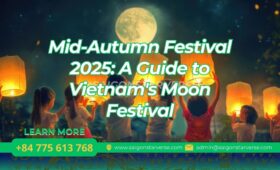Introduction
Music is the soul of a culture, and for Southern Vietnam, that soul is embodied in Don Ca Tai Tu – a traditional form of chamber music deeply tied to the Mekong Delta lifestyle. Recognized by UNESCO in 2013 as Intangible Cultural Heritage of Humanity, Don Ca Tai Tu represents not only a unique art form but also the spirit, resilience, and creativity of Vietnamese people in the South.
In 2025, as tourism focuses more on cultural authenticity, Don Ca Tai Tu has become a highlight in many Mekong Delta itineraries. Tourists can now enjoy live performances during orchard visits, dinner cruises, and cultural shows, making it one of the most memorable experiences in Vietnam.
H2: The Origins of Don Ca Tai Tu
- Historical roots: Emerging in the late 19th century, Don Ca Tai Tu was influenced by court music from Hue and local folk melodies.
- Community practice: It was performed in family gatherings, village festivals, and riverfront evenings.
- Improvisation: Unlike rigid classical music, Don Ca Tai Tu emphasizes improvisation, allowing musicians to adapt and express emotions freely.
Alt text image: “Traditional musicians performing Don Ca Tai Tu on a Mekong riverside”
Keywords: Don Ca Tai Tu history, Vietnam folk music, Southern culture.
H2: Musical Characteristics
H3: Instruments
The ensemble usually features:
- Dan Tranh (zither with 16 strings).
- Dan Nguyet (moon lute).
- Dan Co (two-string fiddle).
- Guitar phím lõm (modified guitar with scooped frets for sliding notes).
- Percussion like song loan (small wooden clapper).
Alt text image: “Close-up of guitar phím lõm used in Don Ca Tai Tu”
Keywords: Vietnamese instruments, Don Ca Tai Tu guitar, Mekong music ensemble.
H3: Singing Style
- Lyrics often celebrate love, loyalty, countryside beauty, and moral values.
- Songs are performed in slow, emotional tones or lively rhythms depending on the occasion.
- Both professional artists and amateurs participate, making it a community art.
Alt text image: “Female singer in traditional ao dai performing Don Ca Tai Tu”
Keywords: Don Ca Tai Tu singing, Vietnamese folk songs, ao dai performance.
H2: Cultural Significance
- A lifestyle expression: Reflects the joy, sadness, and aspirations of Southern farmers and fishermen.
- Social connection: Strengthens community bonds during festivals, weddings, and gatherings.
- Cultural pride: Recognition by UNESCO ensures preservation and global awareness.
Alt text image: “Community gathering for Don Ca Tai Tu in a rural village”
Keywords: UNESCO Vietnam heritage, Mekong culture, Southern folk art.
H2: Don Ca Tai Tu in Tourism 2025
Today, Don Ca Tai Tu is not just preserved but actively integrated into tourism:
- Dinner cruises in Can Tho: Tourists enjoy music while floating on the Hau River.
- Orchard homestays: Local families host intimate performances.
- Festivals: Annual events in Bac Lieu and Can Tho celebrate this art form.
- Interactive workshops: Visitors learn to play instruments or sing simple verses.
Alt text image: “Tourists enjoying Don Ca Tai Tu on a dinner cruise in Can Tho”
Keywords: Don Ca Tai Tu tourism, Mekong cultural tour, Can Tho dinner cruise.
H2: Preservation Efforts
- Training young musicians: Music schools and cultural clubs teach the next generation.
- Community support: Government and NGOs sponsor events to keep the art alive.
- Digitalization: Recordings and online platforms spread awareness globally.
Alt text image: “Young students learning Don Ca Tai Tu at a cultural center”
Keywords: Vietnam music preservation, UNESCO heritage protection.
H2: How to Experience Don Ca Tai Tu
- Attend a performance in Bac Lieu, considered the cradle of Don Ca Tai Tu.
- Join homestay tours in Ben Tre or Can Tho with evening shows.
- Visit during Ok Om Bok Festival or Southern Folk Music Festivals.
- Book a private show as part of a Mekong eco-tour package.
Alt text image: “Don Ca Tai Tu performance at a traditional homestay”
H2: Who Will Love Don Ca Tai Tu?
- Culture enthusiasts: For those who value intangible heritage.
- Families: A wholesome experience that introduces children to Vietnamese traditions.
- International tourists: Offers a deep, authentic connection to Vietnam.
- Students and researchers: A case study in intangible cultural heritage preservation.
Alt text image: “Tourists applauding after Don Ca Tai Tu performance”
H2: Travel Tips
- Performances are usually held in the evening.
- Some shows are free with dinner packages, others require tickets ($5–10).
- Bring a camera, but be respectful during performances.
- Learn a few Vietnamese phrases – locals may invite you to sing along.
Alt text image: “Tourists clapping hands to rhythm of Don Ca Tai Tu”
H2: FAQs
Q: Is Don Ca Tai Tu only for experts?
A: No, it’s both professional and amateur-friendly, anyone can participate.
Q: Where is the best place to hear it?
A: Bac Lieu, Can Tho, and Ben Tre are the most famous.
Q: Why did UNESCO recognize it?
A: For its cultural significance, community spirit, and historical roots.
H2: Conclusion – The Soulful Heritage of Southern Vietnam
Don Ca Tai Tu is not just music; it is the heartbeat of the Mekong Delta. With its emotional melodies, improvisational style, and deep cultural meaning, it has survived for over a century and continues to inspire generations.
For visitors in 2025, experiencing Don Ca Tai Tu means immersing yourself in the soul of Southern Vietnam – a memory you will carry long after leaving the Mekong.
📞 Hotline/Zalo/WhatsApp: +84 775 613 768
📧 Email: admin@saigonstarverse.com
🌐 Website: www.saigonstarverse.com




